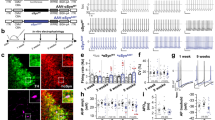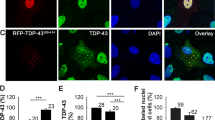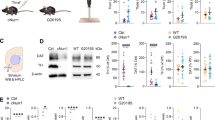Abstract
Loss of noradrenergic locus coeruleus (LC) neurons is a prominent feature of aging-related neurodegenerative diseases, such as Parkinson's disease (PD). The basis of this vulnerability is not understood. To explore possible physiological determinants, we studied LC neurons using electrophysiological and optical approaches in ex vivo mouse brain slices. We found that autonomous activity in LC neurons was accompanied by oscillations in dendritic Ca2+ concentration that were attributable to the opening of L-type Ca2+ channels. This oscillation elevated mitochondrial oxidant stress and was attenuated by inhibition of nitric oxide synthase. The relationship between activity and stress was malleable, as arousal and carbon dioxide increased the spike rate but differentially affected mitochondrial oxidant stress. Oxidant stress was also increased in an animal model of PD. Thus, our results point to activity-dependent Ca2+ entry and a resulting mitochondrial oxidant stress as factors contributing to the vulnerability of LC neurons.
This is a preview of subscription content, access via your institution
Access options
Subscribe to this journal
Receive 12 print issues and online access
$209.00 per year
only $17.42 per issue
Buy this article
- Purchase on Springer Link
- Instant access to full article PDF
Prices may be subject to local taxes which are calculated during checkout







Similar content being viewed by others
References
Aston-Jones, G. & Cohen, J.D. An integrative theory of locus coeruleus–norepinephrine function: adaptive gain and optimal performance. Annu. Rev. Neurosci. 28, 403–450 (2005).
Sara, S.J. The locus coeruleus and noradrenergic modulation of cognition. Nat. Rev. Neurosci. 10, 211–223 (2009).
Park, A. & Stacy, M. Non-motor symptoms in Parkinson's disease. J. Neurol. 256 (suppl. 3), 293–298 (2009).
Surmeier, D.J., Guzman, J.N. & Sanchez-Padilla, J. Calcium, cellular aging, and selective neuronal vulnerability in Parkinson's disease. Cell Calcium 47, 175–182 (2010).
Nicholls, D.G. Oxidative stress and energy crises in neuronal dysfunction. Ann. NY Acad. Sci. 1147, 53–60 (2008).
Bender, A. et al. High levels of mitochondrial DNA deletions in substantia nigra neurons in aging and Parkinson disease. Nat. Genet. 38, 515–517 (2006).
Abou-Sleiman, P.M., Muqit, M.M.K. & Wood, N.W. Expanding insights of mitochondrial dysfunction in Parkinson's disease. Nat. Rev. Neurosci. 7, 207–219 (2006).
Kubota, C. et al. Constitutive reactive oxygen species generation from autophagosome/lysosome in neuronal oxidative toxicity. J. Biol. Chem. 285, 667–674 (2010).
Surmeier, D.J., Guzman, J.N., Sanchez-Padilla, J. & Goldberg, J.A. The origins of oxidant stress in Parkinson's disease and therapeutic strategies. Antioxid. Redox Signal. 14, 1289–1301 (2011).
Surmeier, D.J., Guzman, J.N., Sanchez, J. & Schumacker, P.T. Physiological phenotype and vulnerability in Parkinson's disease. Cold Spring Harb. Perspect. Med. 2, a009290 (2012).
Guzman, J.N. et al. Oxidant stress evoked by pacemaking in dopaminergic neurons is attenuated by DJ-1. Nature 468, 696–700 (2010).
Verkhratsky, A. The endoplasmic reticulum and neuronal calcium signaling. Cell Calcium 32, 393–404 (2002).
McCormack, J.G., Halestrap, A.P. & Denton, R.M. Role of calcium ions in regulation of mammalian intramitochondrial metabolism. Physiol. Rev. 70, 391–425 (1990).
Williams, J.T., North, R.A., Shefner, S.A., Nishi, S. & Egan, T.M. Membrane properties of rat locus coeruleus neurones. Neuroscience 13, 137–156 (1984).
Filosa, J.A. & Putnam, R.W. Multiple targets of chemosensitive signaling in locus coeruleus neurons: role of K+ and Ca2+ channels. Am. J. Physiol. Cell Physiol. 284, C145–C155 (2003).
Imber, A.N. & Putnam, R.W. Postnatal development and activation of L-type Ca2+ currents in locus ceruleus neurons: implications for a role for Ca2+ in central chemosensitivity. J. Appl. Physiol. 112, 1715–1726 (2012).
Christie, M.J., Williams, J.T. & North, R.A. Electrical coupling synchronizes subthreshold activity in locus coeruleus neurons in vitro from neonatal rats. J. Neurosci. 9, 3584–3589 (1989).
North, R.A. & Williams, J.T. Opiate activation of potassium conductance inhibits calcium action potentials in rat locus coeruleus neurones. Br. J. Pharmacol. 80, 225–228 (1983).
Kang, S. et al. Structure-activity relationship of N,N′-disubstituted pyrimidinetriones as Ca(V)1.3 calcium channel–selective antagonists for Parkinson's disease. J. Med. Chem. 56, 4786–4797 (2013).
Guzman, J.N., Sanchez-Padilla, J., Chan, C.S. & Surmeier, D.J. Robust pacemaking in substantia nigra dopaminergic neurons. J. Neurosci. 29, 11011–11019 (2009).
Foehring, R.C., Zhang, X.F., Lee, J.C.F. & Callaway, J.C. Endogenous calcium buffering capacity of substantia nigral dopamine neurons. J. Neurophysiol. 102, 2326–2333 (2009).
Maravall, M., Mainen, Z.F., Sabatini, B.L. & Svoboda, K. Estimating intracellular calcium concentrations and buffering without wavelength ratioing. Biophys. J. 78, 2655–2667 (2000).
Fierro, L. & Llano, I. High endogenous calcium buffering in Purkinje cells from rat cerebellar slices. J. Physiol. (Lond.) 496, 617–625 (1996).
Dooley, C.T. et al. Imaging dynamic redox changes in mammalian cells with green fluorescent protein indicators. J. Biol. Chem. 279, 22284–22293 (2004).
Wang, H.-Q. & Takahashi, R. Expanding insights on the involvement of endoplasmic reticulum stress in Parkinson's disease. Antioxid. Redox Signal. 9, 553–561 (2007).
Patergnani, S. et al. Calcium signaling around mitochondria-associated membranes (MAMs). Cell Commun. Signal. 9, 19 (2011).
Brand, M.D. et al. Mitochondrial superoxide and aging: uncoupling–protein activity and superoxide production. Biochem. Soc. Symp. 74, 203–213 (2004).
Cookson, M.R. Parkinsonism due to mutations in PINK1, parkin and DJ-1 and oxidative stress and mitochondrial pathways. Cold Spring Harb. Perspect. Med. 2, a009415 (2012).
Goldberg, J.A. et al. Calcium entry induces mitochondrial oxidant stress in vagal neurons at risk in Parkinson's disease. Nat. Neurosci. 15, 1414–1421 (2012).
Samuels, E.R. & Szabadi, E. Functional neuroanatomy of the noradrenergic locus coeruleus: its roles in the regulation of arousal and autonomic function part II: physiological and pharmacological manipulations and pathological alterations of locus coeruleus activity in humans. Curr. Neuropharmacol. 6, 254–285 (2008).
Berridge, C.W., España, R.A. & Vittoz, N.M. Hypocretin/orexin in arousal and stress. Brain Res. 1314, 91–102 (2010).
Horvath, T.L. et al. Hypocretin (orexin) activation and synaptic innervation of the locus coeruleus noradrenergic system. J. Comp. Neurol. 415, 145–159 (1999).
van den Pol, A.N. et al. Hypocretin (orexin) enhances neuron activity and cell synchrony in developing mouse GFP-expressing locus coeruleus. J. Physiol. (Lond.) 541, 169–185 (2002).
Soffin, E.M. et al. SB-334867-A antagonizes orexin-mediated excitation in the locus coeruleus. Neuropharmacology 42, 127–133 (2002).
Murphy, M.P. How mitochondria produce reactive oxygen species. Biochem. J. 417, 1–13 (2009).
Marks, J.D., Boriboun, C. & Wang, J. Mitochondrial nitric oxide mediates decreased vulnerability of hippocampal neurons from immature animals to NMDA. J. Neurosci. 25, 6561–6575 (2005).
Traaseth, N., Elfering, S., Solien, J., Haynes, V. & Giulivi, C. Role of calcium signaling in the activation of mitochondrial nitric oxide synthase and citric acid cycle. Biochim. Biophys. Acta 1658, 64–71 (2004).
White, R.J. & Reynolds, I.J. Mitochondria accumulate Ca2+ following intense glutamate stimulation of cultured rat forebrain neurones. J. Physiol. 498, 31–47 (1997).
Waypa, G.B. et al. Hypoxia triggers subcellular compartmental redox signaling in vascular smooth muscle cells. Circ. Res. 106, 526–535 (2010).
Nedergaard, S., Flatman, J.A. & Engberg, I. Nifedipine- and omega-conotoxin–sensitive Ca2+ conductances in guinea pig substantia nigra pars compacta neurones. J. Physiol. (Lond.) 466, 727–747 (1993).
Wilson, C.J. & Callaway, J.C. Coupled oscillator model of the dopaminergic neuron of the substantia nigra. J. Neurophysiol. 83, 3084–3100 (2000).
Berridge, M.J. The endoplasmic reticulum: a multifunctional signaling organelle. Cell Calcium 32, 235–249 (2002).
Mosharov, E.V. et al. Interplay between cytosolic dopamine, calcium, and alpha-synuclein causes selective death of substantia nigra neurons. Neuron 62, 218–229 (2009).
Samuels, E.R. & Szabadi, E. Functional neuroanatomy of the noradrenergic locus coeruleus: its roles in the regulation of arousal and autonomic function part I: principles of functional organisation. Curr. Neuropharmacol. 6, 235–253 (2008).
Aston-Jones, G. & Bloom, F.E. Activity of norepinephrine-containing locus coeruleus neurons in behaving rats anticipates fluctuations in the sleep-waking cycle. J. Neurosci. 1, 876–886 (1981).
Gargaglioni, L.H., Hartzler, L.K. & Putnam, R.W. The locus coeruleus and central chemosensitivity. Respir. Physiol. Neurobiol. 173, 264–273 (2010).
Surmeier, D.J., Guzman, J.N., Sanchez-Padilla, J. & Goldberg, J.A. The origins of oxidant stress in Parkinson's disease and therapeutic strategies. Antioxid. Redox Signal. 14, 1289–1301 (2011).
Wardman, P. Fluorescent and luminescent probes for measurement of oxidative and nitrosative species in cells and tissues: progress, pitfalls, and prospects. Free Radic. Biol. Med. 43, 995–1022 (2007).
Becker, C., Jick, S.S. & Meier, C.R. Use of antihypertensives and the risk of Parkinson disease. Neurology 70, 1438–1444 (2008).
Anekonda, T.S. & Quinn, J.F. Calcium channel blocking as a therapeutic strategy for Alzheimer's disease: the case for isradipine. Biochim. Biophys. Acta 1812, 1584–1590 (2011).
Acknowledgements
We acknowledge the technical help of S. Ulrich, Y. Chen, L. Fisher and K. Chen. We acknowledge S. Chan (Northwestern University) for supplying qPCR primer sets and J.T. Walter (Northwestern University) for supplying GP recordings. This work was supported by the JPB and IDP Foundations, US National Institutes of Health grants NS047085 (D.J.S.), NS054850 (D.J.S.), K12GM088020 (J.S.-P.), HL35440 (P.T.S.) and RR025355 (P.T.S.), and Department of Defense contracts W81XWH-07-1-0170 and W23RYX-2150-N601 (D.J.S.). The authors gratefully thank the laboratory of T. Dawson (Johns Hopkins University) for providing DJ-1−/− mice.
Author information
Authors and Affiliations
Contributions
D.J.S., J.S.-P. and J.N.G. were responsible for the design and execution of experiments, as well as the analysis of results and overall direction of the experiments, analysis of data, construction of figures and communication of the results. W.O. participated in the design and the communication of the results. S.S. and D.J.G. contributed to collecting electrophysiological and relative oxidation data, respectively. B.Y. performed stereotaxic viral injections. D.W. provided expertise in optical approaches. J.S.-P. and E.I. conducted the immunocytochemical experiments. J.K. generated the AAV virus for the CMV–mito-roGFP stereotaxic injections. P.T.S. was responsible for the generation of the CMV–mito-roGFP mice and participated in the design, analysis and communication of the results. D.J.S. and J.S.-P. prepared the manuscript and the illustrations.
Corresponding author
Ethics declarations
Competing interests
The authors declare no competing financial interests.
Integrated supplementary information
Supplementary Figure 1 Colocalisation of LC neuronal biomarkers.
(a) Left panel shows immunoreactive LC neurons for tyrosine hydroxylase (TH). Middle panel shows immunoreactivity of LC neurons for dopamine-β-hydroxylase (DBH). Right panel displays merged immunostaining for TH and DBH showing complete overlap and confirmation of proper anatomical location for LC neurons.
Supplementary Figure 2 LC neurons have functional expression of Ca2+ channels.
(a) Somatic voltage clamp experiments were performed using the command action potential waveform obtained from a pacemaking LC neuron. Outward K+ currents were blocked using 5 mM TEA in the bath and recordings were performed under low external Na+ (50 mM), and Cs+-based internal solution supplemented with 5 mM TEA. (b) Ionic current measurements in response to the action potential waveform were sampled during normal external [Ca2+], following TTX to remove Nav1 component, and following equimolar substitution of Ca2+ with cobalt (Co2+). Co2+-sensitive currents were calculated by subtracting ionic current obtained with TTX and 2 mM Co2+ from ionic currents obtained in the presence of TTX and 2 mM Ca2+. (c) LC neurons display a subthreshold inward current during the inter-spike interval). (d) LC neurons also display a significant inward spike-associated current. (e) Box-plot quantification of charge for subthreshold and spike currents. (f) Box-plot quantification demonstrating that subthreshold inward currents carry approximately 70% of charge and the remaining 30% carried by the spike Data represents n=4 neurons from 4 mice, p=0.0143, Mann-Whitney).
Supplementary Figure 3 Ectopic spikes reset dendritic Ca2+ oscillations in LC neurons.
(a) Ectopic spikes induced by a short pulse of positive injection (2 nA, 1msec) resets the pacemaking cycle synchronized to dendritic Ca2+ transients. (b) After silencing an LC neuron with hyperpolarizing current, ectopic spikes can elicit dendritic Ca2+ transients. Data represents n=4 neurons from 4 mice.
Supplementary Figure 4 LC neurons express Nav1 and NALCN channels.
(a) Box-plot quantification of relative mRNA abundance for Nav1 channels in SNc and LC (n=5 mice). (b) Box-plot quantification of relative mRNA abundance for NALCN channels in SNc and LC (n=5 mice). (c) Sample trace of pacemaking and spikelets (with TTX). (d) LC neurons after isradipine eliminates spikelets and membrane potential remains depolarized, and sodium replacement with N-methyl-D-Glucamine (NMDG) hyperpolarizes LC neurons, suggesting a strong contribution of NALCN channels in LC neurons. (e) Box-plot quantification of membrane potential under normal Na+ and equimolar substitution with NMDG (n=4 neurons from 4 mice, p=0.0284, Mann-Whitney).
Supplementary Figure 5 Time course of Fluo4 dye loading in LC neurons synchronized to spike-evoked Ca2+ transients.
(a) Representative time course plotting Fluo4 (200 μM in the pipette) fluorescence as a function of time after whole cell break in. Fluorescence was sampled in the soma. During the time course of dye loading, action potential spikes were evoked in silenced LC neurons (shown in inset), and evoked Ca2+ transients were analyzed for buffering capacity calculations until dye reached equilibrium (∼5-10 min for soma).
Supplementary Figure 6 NOS inhibition inhibits NO production in LC neurons.
(a) DAF-FM fluorescence was measured in LC neurons every five minutes, before and after bath application of 100 μM L-NAME (10 min). The increase fluorescence is an indicator of increased NO production, calculated by linear fit, giving rise to a slope that indicates rate of NO production. L-NAME decreased the rate of NO production, shown by a decrease in the slope (middle panel). (b) Quantification of rate of NO production (slope) before and after L-NAME (n=4 neurons from 4 mice, p=0.042, one-tailed paired-t test, normal distribution was assumed but not tested formally).
Supplementary information
Supplementary Text and Figures
Supplementary Figures 1–6 (PDF 777 kb)
Rights and permissions
About this article
Cite this article
Sanchez-Padilla, J., Guzman, J., Ilijic, E. et al. Mitochondrial oxidant stress in locus coeruleus is regulated by activity and nitric oxide synthase. Nat Neurosci 17, 832–840 (2014). https://doi.org/10.1038/nn.3717
Received:
Accepted:
Published:
Issue Date:
DOI: https://doi.org/10.1038/nn.3717
This article is cited by
-
Mitochondrial dysfunction in Parkinson’s disease – a key disease hallmark with therapeutic potential
Molecular Neurodegeneration (2023)
-
Overexpression-Induced α-Synuclein Brain Spreading
Neurotherapeutics (2023)
-
Dietary Tyrosine Intake (FFQ) Is Associated with Locus Coeruleus, Attention and Grey Matter Maintenance: An MRI Structural Study on 398 Healthy Individuals of the Berlin Aging Study-II
The Journal of nutrition, health and aging (2023)
-
Enhanced firing of locus coeruleus neurons and SK channel dysfunction are conserved in distinct models of prodromal Parkinson’s disease
Scientific Reports (2022)
-
The mechanistic link between selective vulnerability of the locus coeruleus and neurodegeneration in Alzheimer’s disease
Acta Neuropathologica (2021)



